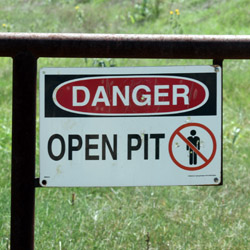
A sign outside of a limestone mining operation on the Arbuckle-Simpson Aquifer warns trespassers not to enter the quarry.
Joe Wertz / StateImpact Oklahoma


A sign outside of a limestone mining operation on the Arbuckle-Simpson Aquifer warns trespassers not to enter the quarry.
Joe Wertz / StateImpact Oklahoma

Joe Wertz / StateImpact Oklahoma
Shannon Shirley lives near Ada, Okla. on 200 acres of land that depends on water from a nearby creek, which she says has been harmed by nearby limestone and sand mines.
Shannon Shirley’s land along Mill Creek is rich in natural resources: Massive granite boulders worn to their current shape after millions of years of erosion, a carpet of limestone and the creek they’ve relied on for water for more than 15 years. She now calls that stream ‘dysfunctional.’
“We bring in water as a backup source because you never know,” she says. “Day-to-day the levels change.”
And she blames the mining operations just upstream from her house.
“When you mine the rock that they’re mining — they’re mining limestone and silica sand. And when you mine that, you encounter water just as a natural process of mining it, because this stuff is in water,” Shirley says. “So water becomes a byproduct of mining and you’ve got to get it out of the way.”

Joe Wertz / StateImpact Oklahoma
Water for Shannon Shirley's home is pumped out of Mill Creek, which is fed by Oklahoma's ecologically sensitive Arbuckle-Simpson Aquifer. Click for a larger version.
Mining operations can build storage ponds or pump excess water into the creek, but Shirley says many simply dump it onto the ground. Richard Szecsy, of the Texas Aggregates and Concrete Association, says that’s bad business and companies should recycle the water, but that it’s hard to put the blame for lower stream levels on mining during a major drought.
“These are those obvious facts, that’s kind of like, ‘did anyone think of that?’ No! It’s the quarry. The quarry’s bad. Well, hello, we’ve been in a drought for two and a half years,” Szecsy says.
Either way, Shirley can’t rely on Mill Creek for drinking water anymore. She’s worried that Mill Creek is the canary in the limestone mine for municipalities that rely on other streams and lakes fed by the Arbuckle-Simpson Aquifer.
“Mill Creek will be the first to go. And then it’ll be a domino,” Shirley says. “Springs are at the top of the aquifer. As you lower the level of the aquifer, you take the water away from the springs. And Mill Creek is ground zero for that. And then comes Pennington, which is less than a mile away. And then comes Rock Creek, and this way, toward Ardmore, their lake is spring fed. Sulphur, at the park, they have spring fed creeks.”
[module align=”right” width=”half” type=”pull-quote”]
“Mill Creek will be the first to go. And then it’ll be a domino,”
[/module]
Shirley is a member of Citizens for the Protection of the Arbuckle-Simpson Aquifer, which in 2011 pushed a bill to regulate the water removed by mining operations. The new rules go into effect in January. Companies applying for mining permits in the aquifer after August 1st of last year will have to report how much water they’re removing and submit a plan to recycle it.
State Representative Todd Thomsen (R-Ada) co-authored the bill and says it’s just common sense.

Joe Wertz / StateImpact Oklahoma
Shannon Shirley points out a dry portion of Mill Creek a few miles downstream from her home.
“We have a lot of natural resources …and that natural resource happens to right on top of that aquifer. There’s a great concern with the use of that water and the depletion of that aquifer and how it’s going to impact — because there are so many in that area that directly use that aquifer,” Thomsen says. “So, there’s great interest in how much those mines are potentially taking as they do their mining operation. And up until the point of that legislation, there had really been no formal reporting and monitoring of that.”
The August 1st 2011 deadline caused an unusual amount of activity at what is usually a quiet state agency.
“We had about half a dozen who came in the last week of July 2011,” Bret Sholar, with the Oklahoma Department of Mines says.
He says current operations will only have to abide by the reporting part of the new law, and it’ll be up to the companies to file those reports. Even though these new rules go into effect in January, they’re still being worked out at the Oklahoma Water Resources Board.
“We’re going to come up on January 2013 here pretty soon, and these people are going to start doing these monitoring plans,” Sholar says. “No one knows how. How’s it going to be funded? What do they do?”
The mining companies clearly don’t want to have to deal with the new rules. Since last year’s deadline, the state mining department has received zero new applications to enter the aquifer.